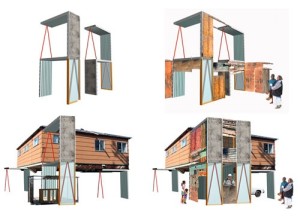In the final section of the book Spatial Agency, the author discusses how spatial agents operate the concept inherent in these operations of the groups and practices.
It leads to the rethinking about the role of architects, especially in practices related to informal condition. Architecture can no longer be a beautified and technologized object and solve all problems alone. Especially when the book introduces spatial “appropriation”, architects need to face the fact of squatting and illegal self-building practices, in which new activities are created and embedded with long-term opportunities. The production and knowledge of clients and other forces is relatively more important compared to that in formal projects and should be included in the process of construction. The mark of architecture project’s completion has to be extended in order to consider the use of clients (informal recreate). However, the book also points out that today too often over-determined projects lead to inefficiency of space, as over-determined space is hard to transfer for other usage. While, some “slack” space, considered as wasteful and uneconomical, provides delight indeterminacy for everyday ordinary needs of transformation of space. Architects’ job is to set up the framework of a project with their professional knowledge and leave space for the inhabitation. In Teddy Cruz’s description about his practices in San Diego and Tijuana’s borderline, he invents a frame that cooperates with recycled materials and other human resource to “help dwellers optimize the threading of certain popular elements, such as pallet racks and recycled joists” as well as “acts as a formwork, allowing the user to experiment with different materials and finishes.” (Cruz, 35) Plus, the stair system benefited from this frame intervention accelerates the receiving of recycled houses from San Diego. The scale of architect’s part in this practice is relatively small, which is just simple transformable frame. However, the scale of this project is expanded incredibly big through the process of using these frames by residence with collective force. The indeterminacy is the basis for more future possibilities of the projects.
Based on the understanding of limitation of architecture and architects’ skill, we should agree with Marcuse’s view of using our skills in coalition with other groups to solve issues of capitalism in complex urban informality. In the book, author believes that “spatial agency is driven by the managing and administration of means such as labor, time and space.” Architects, as one important role with professional knowledge in the spatial agency, should take the initiation to collaborate with all other forces and spend time negotiating in order to make up the limitation in our knowledge and ability when facing such complex systems. When talking about “sharing knowledge”, the book says “architecture was not about supposedly neutral form, but about the collaboration with others in an attempt to make architecture and architectural tools more relevant to a broader section of society.” (Spatial agency, 78) In Teddy Cruz’s project in Tijuana, distribution of goods, ad-hoc services and the whole material recycling system connecting Tijuana and San Diego are all important aspects that architects need to negotiate and take into consideration in addition to the design.
1. Spatial Agency
2.Teddy Cruz, Tijuana Case Study
